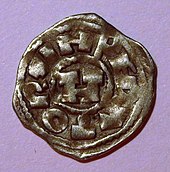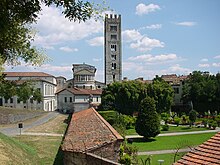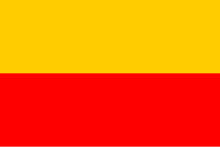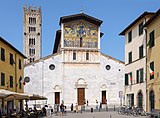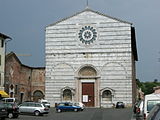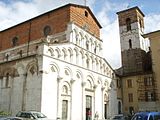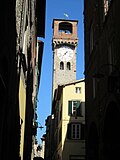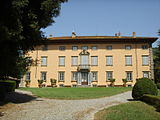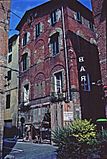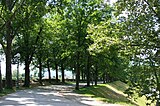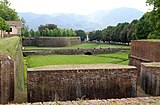Lucca
| Lucca | ||
|---|---|---|

|
|
|
| Country | Italy | |
| region | Tuscany | |
| province | Lucca (LU) | |
| Coordinates | 43 ° 51 ' N , 10 ° 30' E | |
| height | 19 m slm | |
| surface | 185.5 km² | |
| Residents | 90,055 (Dec. 31, 2019) | |
| Population density | 485 inhabitants / km² | |
| Post Code | 55100 | |
| prefix | 0583 | |
| ISTAT number | 046017 | |
| Popular name | Lucchesi | |
| Patron saint | San Paolino di Lucca | |
| Website | www.comune.lucca.it | |
 View over Lucca from the tower on the Palazzo Guinigi |
||
Lucca (in ancient times: Luca ) is the capital of the province of Lucca in Tuscany with 90,055 inhabitants (as of December 31, 2019). It is located in the valley of the Serchio River, about 20 km northeast of Pisa and 20 km east of the Tuscan coast. In the 13th and 14th centuries, Lucca was one of the most influential European cities. The textile industry was particularly important. The large squares, the Romanesque churches and the medieval towers bear witness to the former importance of this city. Its fortifications, pierced by four gates, were started in 1504 and completed in 1645. The complexes, which are still well-preserved today and which have long been among the most remarkable in Italy, support a tree-lined promenade around the city center.
history
Antiquity to Renaissance
The ancient Etruscan Lucca, which ruled the valley of the Serchio , is first mentioned by the historian Livy as the place where Sempronius went in 218 BC. BC withdrew before Hannibal ; there are doubts as to the correctness of Livy’s statement, because although there were continuous wars with the Ligurians , Lucca did not become known until 180 BC. Chr. Named again. At that time, Lucca was founded as a Roman colony at the same time as Pisa (also 180) and Luna (177) in order to be able to finally break the rule of the Apuanians who had previously lived in this area and to take possession of the land for Rome. Through the Lex Julia from 90 BC It must have become a municipium ; here Julius Caesar held 56 BC His famous meeting with Pompey and Crassus . At that time, Lucca was still part of Liguria, not Etruria . A little later a colony was led here by the triumvirate or by Octavian, whether after the battle of Philippi or after that of Actium is unclear.
In the Augustan subdivision of Italy, Lucca was assigned to the seventh region (Etruria) . Little is known of the period of the Empire, except that it was a crossroads of the roads to Florentia (see Via Clodia ), Luna and Pisae . Although it was sacked by Odoacer and stripped of part of its territory, Lucca appears as an important city and fortress at the time of Narses , who besieged it for three months in 553. Under the Lombards , Lucca was the residence of a duke or margrave who had the privilege to mint. The dukes gradually extended their power to the whole of Tuscany , but after the death of the famous Matilda , the city began to constitute itself as an independent commune. In 1160 it received it from the Bavarian Duke and Tuscan Margrave Welf VI. in return for an annual tribute, the rule of a territory around the city. The wealth and influence of the city of Lucca in the 13th century was based in large part on its textile industry . Lucca was famous, among other things, for its silk , the splendor of which was considered unsurpassed in Europe.
Internal disagreement gave Uguccione della Faggiola , with whom Dante spent some time there, the opportunity to make himself lord of Lucca in 1314, but the Lucchesi expelled him two years later and handed the city over to Castruccio Castracani , under whose skilful tyranny it was for a short time until his death in 1328 - his grave is in the church of San Francesco - became the leading city in Italy. Political unrest at the beginning of the 14th century, however, led many Luccheser dyers and silk weavers to flee to Venice . The city of Venice generously offered the refugees asylum and financial aid, but on the condition that they practiced their trade in Venice. The Luccheser guild laws provided death for all citizens who practiced their textile trade outside the city walls, but given their financial situation, many Luccheser craftsmen accepted the Venetian conditions.
Occupied by the troops of Ludwig of Bavaria , sold to the wealthy Genoese Gheradino Spinola , occupied by the Bohemian King John , pledged to the Rossi from Parma , ceded to Mastino della Scala from Verona, sold to the Florentines, handed over to the Pisans , nominal Liberated by Emperor Charles IV and ruled by his vicar, Lucca was able to maintain its independence as a city republic alongside Venice and Genoa, first as a democracy from 1369, then as a patrician-aristocratic oligarchy after 1628 . Until the French Revolution , it wrote the word Libertas on its flags. The political turmoil of the 13th and 14th centuries were thematized by Dante in his work, Leeck (2007) explains using the case studies of Alessio Interminelli, Bonturo Dati and Bonagiunta.
From the 16th century
In the early sixteenth century one of its leading citizens, Francesco Burlamacchi , made an attempt to give Italy political cohesion, but fell on the scaffold; his monument by Ulisse Cambi was erected in Piazza San Michele in 1863.
Due to the military power of the victorious French revolutionary armies, which ended the Austrian supremacy over Italy, the Republic of Lucca was forced in 1799/1800 to introduce a modern "democracy" based on the French model and in complete dependence on Napoleon Bonaparte's France ( Lucchese Republic ). In June 1805, Napoleon Bonaparte, who had meanwhile been proclaimed Emperor of the French and King of Italy, decreed the abolition of the republic, which was instead transformed into the Principality of Lucca in favor of his sister Elisa and her husband Félix Baciocchi . During the fall of Napoleon in 1814, Lucca was briefly occupied by Neapolitan and then by Austrian troops. At the Congress of Vienna , which decided on the reorganization of Europe in 1814/15, the small but prosperous state of Lucca became a means of displacement and compensation for dynastic and power-political interests. The Empire of Austria at the time refused - despite the cherished otherwise he dynastic principle of legitimacy - the Bourbon Duke of Parma to return to the main cities of Parma and Piacenza , the lifetime as a supply area for Napoleon's wife, the former French Empress Marie Louise († 1847), a daughter of Francis I , were provided. As long as Marie Louise lived, the Parmesian Bourbons were instead to be compensated with the former Republic of Lucca as a duchy , which, however , should fall to the Habsburg Grand Duchy of Tuscany (and thus under the influence of Austria) after the Bourbons were transferred to Parma and Piacenza . After long resistance from the House of Bourbon-Parma, which was supported (in vain) by the closely related Spanish King Ferdinand VII , Ferdinand's sister Maria Luisa (who, under Napoleon, had temporarily been queen and regent of the " Kingdom of Etruria " formed in Tuscany ) stepped in . , in November 1817 the rule as Duchess of Lucca. With her death in 1824 her son Karl Ludwig († 1883), the former child king of Etruria, followed. Due to the worsening domestic political situation in the run-up to the revolution of 1848/49, however, in October 1847, before the death of the Parmesan-Habsburg ruler Marie Louise, in favor of the Grand Duke of Tuscany, he renounced the government in Lucca. Since then, the duchy has formed part of Tuscany, with which it was attached first to Sardinia and then to the new unitary state of Italy during the Risorgimento of 1859/61 .
Attractions
The right-angled street network in the historical center still shows the structure of the Roman complex. The ancient city wall ran along the current street Via San Giorgio / A. Mordini - Via dell'Angelo Custode / della Rosa - Corso Garibaldi - Via della Cittadella / Galli Tassi. The forum was located at the intersection of Cardo and Decumanus , and since the Middle Ages has been Piazza San Michele . In the name of the Church of San Michele in Foro , this Roman heritage lives on to our times.
Lucca is rich in sights and therefore of great tourist interest.
Churches
Secular buildings and squares
Torre dell'Orologio or Torre delle Ore (clock tower)
Palazzo Ducale , Piazza Napoleone
Villa Oliva , district of San Pancrazio
The birth house of the composer Giacomo Puccini now houses a museum. The Italian state has awarded the house - together with the museum birth houses of Gioachino Rossini and Giuseppe Verdi - the European Heritage Seal (according to the old system until 2010 ).
City wall and city gates
Possibly the most impressive building in the city is the completely preserved city wall of Lucca , in Italian Mura di Lucca . It originated in the Middle Ages when it was in the 12th / 13th centuries In the 17th century, the Roman wall replaced it to include the Borghi San Frediano, San Pietro Somaldi and Santa Mari Forisportam in the northeast. The next, more marginal extension followed in 1504 - 1648 the extension to the city wall as it is presented today: 4.2 km long, with 11 bastions and 12 curtains . The curious thing: the wall was never really used for defense. After all, it saved Lucca from being flooded by the floods of 1812. Maria Luisa of Bourbon-Spain , 1815-1824 Duchess of Lucca, had a promenade built on the wall and the bastions and outside areas greened. Both the promenade and the green areas are extremely popular areas for sporting activities and events.
When the wall was expanded, only three city gates were originally planned: the Porta di Santa Maria in the north, the Porta di San Donato in the north-west and the Porta di San Pietro in the south-west. The eastern part only received a gate in 1804. It is called after its builder of the Princess of Lucca Elisa Bonaparte , Porta Elisa . Two other gateways, the Porta San Jacopo in the northeast and the Porta Sant'Anna in the west, are more recent. The medieval city wall also had four city gates. The two still preserved, the Porta San Gervasio (or Portone dell'Anunziata ) and the Porta dei Borghi , are now within the wall.
Town twinning
Lucca has official partnerships with five European cities and one overseas city:
-
 Abingdon in South East England
Abingdon in South East England
-
 Schongau in Bavaria
Schongau in Bavaria
-
 Colmar in Alsace
Colmar in Alsace
-
 Sint-Niklaas in Flanders
Sint-Niklaas in Flanders
-
 Gorinchem in South Holland
Gorinchem in South Holland
-
 South San Francisco in California
South San Francisco in California
sons and daughters of the town
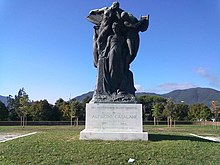

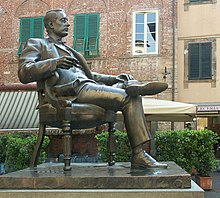
- Giovanni Battista Andreoni (1720–1797), opera singer
- Michelangelo Anselmi (~ 1491 / 92– ~ 1554/56), painter and fresco
- Renato Balestrero (1898–1948), racing car driver
- Bandello Bandelli (1350-1415), cardinal
- Bonviso Bonvisi (1551–1603), Archbishop of Bari and cardinal
- Francesco Buonamici (1596–1677), architect and painter
- Francesco Barsanti (1690–1770), composer, oboist and flutist
- Pompeo Batoni (1708–1787), painter
- Mansueto Bianchi (1949-2016), Bishop of Pistoia
- Luigi Boccherini (1743–1805), composer and cellist
- Luna Carocci (* 1988), volleyball player
- Castruccio Castracani (1281-1328), Duke of Lucca
- Alfredo Catalani (1854-1893), opera composer
- Matteo Civitali (1436–1501), sculptor and painter
- Gabriele Del Grande (* 1982), journalist, writer and human rights activist
- Ubaldo Diciotti (1878–1963), Major General of the Italian Coast Guard
- Carlo Diodati (1541–1625), patrician and trader who emigrated to Geneva in 1567 because of his evangelical faith
- Michela Fanini (1973–1994), cyclist
- Piero Frassi (* 1971), jazz musician
- Gianluca Fulvetti (* 1973), historian
- Francesco Geminiani (1687–1762), composer and violinist
- Giovanni Giorgi (1871–1950), physicist and mathematician
- Giambattista Giusti (1758–1829), engineer and translator
- Giovanni Lorenzo Gregori (1663–1745), violinist and Baroque composer
- Helena Guerra (1835–1914), religious sister and founder of an order; Beatification on April 26, 1959 by Pope John XXIII.
- Lucius III. (1097-1185), Pope
- Vincenzo Lunardi (1759–1806), aviation pioneer and diplomat
- Giovanni Malfatti (1775–1859), doctor in Vienna, personal physician to Archduchess Maria Beatrice d'Este
- Cristofano Malvezzi (1547–1599), organist and composer of the Renaissance
- Domenico Martinelli (1650–1719), architect who also worked in Vienna from 1690–1705
- Felice Matteucci (1808–1887), engineer, co-inventor of an internal combustion engine
- Mazzino Montinari (1928–1986), historian and Germanist
- Luigi Nerici (around 1831–1885), composer and author of the Storia della musica in Lucca (1879)
- Leo Nomellini (1924-2000) American football player
- Andrea Pacini , called " Il Lucchesino " (* approx. 1690–1764), former castrato, opera singer and clergyman
- Santi Pagnini (1470–1541), Bible scholar
- Pietro Paolini (1603–1681), painter
- Paschal III. († 1168), antipope to Alexander III
- Mario Pieri (1860–1913), mathematician
- Raffaele Pierotti (1836–1905), cardinal
- Giacomo Puccini (1858-1924), composer
- Giuseppe Puppo (1749–1827), composer and conductor
- Carlo Ludovico Ragghianti (1910–1987), art historian
- Eros Riccio (* 1977), correspondence chess player
- Giovanni Sercambi (1348–1424), writer and statesman
- Fausto Tardelli (* 1951), Bishop of Pistoia
- Pietro Testa (1611–1650), draftsman, painter and etcher
- Francesco Tomei (* 1985), racing cyclist
literature
- Katrin Dort: Welfare for the poor in Lucca in the early and high Middle Ages: Hospitals in the city and diocese (= Trier historical research , volume 70), Kliomedia, Trier 2015, ISBN 978-3-89890-192-5 (revised dissertation University of Trier 2011, 375 Pages).
- Amy Butler Greenfield: A Perfect Red: Empire, Espionage and the Quest for the Color of Desire . HarperCollins, New York 2004, ISBN 0-06-052275-5 .
Web links
Individual evidence
- ↑ Statistiche demografiche ISTAT. Monthly population statistics of the Istituto Nazionale di Statistica , as of December 31 of 2019.
- ^ Hermann Bengtson: Roman history. Republic and Imperial Era until 284 AD , p. 108
- ^ Amy Butler Greenfield: A Perfect Red. Empire, Espionage and the Quest for the Color of Desire , p. 5
- ↑ Amy Butler Greenfield: A Perfect Red. Empire, Espionage and the Quest for the Color of Desire , p. 6
- ^ Lucca and surroundings . Travel guide with city map. Officina Grafica Bolognese, Bologna 2005, pages 9-12
← Previous location: Camaiore 24.2 km | Lucca | Next town: Capannori 6.8 km →
![]() Canterbury |
Dover |
Calais |
Wissant |
Guînes |
Licques |
Wisques |
Thérouanne |
Auchy-au-Bois |
Bruay-la-Buissière |
Arras |
Bapaume |
Peronne |
Doingt |
Seraucourt-le-Grand |
Tergnier |
Laon |
Bouconville-Vauclair |
Corbeny |
Hermonville |
Reims |
Trépail |
Châlons-en-Champagne |
Cool |
Brienne-le-Château |
Bar-sur-Aube |
Châteauvillain |
Blessonville |
Langres |
Humes-Jorquenay |
Coublanc |
Grenant |
Dampierre-sur-Salon |
Savoyeux |
Seveux |
Gy |
Cussey-sur-l'Ognon |
Besançon |
Étalans |
Chasnans |
Nods |
Ouhans |
Pontarlier |
Yverdon-les-Bains |
Orbe |
Lausanne |
Cully |
Vevey |
Montreux |
Villeneuve |
Aigle |
Saint-Maurice |
Martigny |
Orsières |
Bourg-Saint-Pierre |
Great St. Bernhard |
Saint-Rhémy-en-Bosses |
Saint-Oyen |
Étroubles |
Gignod |
Aosta |
Saint-Christophe |
Quart |
Nut |
Verrayes |
Chambave |
Saint-Denis |
Châtillon |
Saint-Vincent |
Montjovet |
Issogne |
Verrès |
Arnad |
Hône |
Bard |
Donnas |
Pont-Saint-Martin |
Carema |
Settimo Vittone |
Borgofranco d'Ivrea |
Montalto Dora |
Ivrea |
Cascinette d'Ivrea |
Burolo |
Bollengo |
Palazzo Canavese |
Piverone |
Azeglio |
Viverone |
Roppolo |
Cavaglià |
Santhià |
San Germano Vercellese |
Olcenengo |
Salasco |
Sali Vercellese |
Vercelli |
Palestro |
Robbio |
Nicorvo |
Castelnovetto |
Albonese |
Mortara |
Cergnago |
Tromello |
Garlasco |
Gropello Cairoli |
Villanova d'Ardenghi |
Zerbolò |
Carbonara al Ticino |
Pavia |
Valle Salimbene |
Linarolo |
Belgioioso |
Torre de 'Negri |
Costa de 'Nobili |
Santa Cristina e Bissone |
Miradolo Terme |
Chignolo Po |
San Colombano al Lambro |
Orio Litta |
Senna Lodigiana |
Calendasco |
Rottofreno |
Piacenza |
Podenzano |
San Giorgio Piacentino |
Pontenure |
Carpaneto Piacentino |
Cadeo |
Fiorenzuola d'Arda |
Chiaravalle della Colomba |
Alseno |
Busseto |
Fidenza |
Costamezzana |
Noceto |
Medesano |
Fornovo di Taro |
Terenzo |
Berceto |
Pontremoli |
Filattiera |
Villafranca in Lunigiana |
Bagnone |
Licciana Nardi |
Aulla |
Santo Stefano di Magra |
Sarzana |
Castelnuovo Magra |
Ortonovo |
Luni |
Fosdinovo |
Carrara |
Massa |
Montignoso |
Seravezza |
Pietrasanta |
Camaiore |
Lucca |
Capannori |
Porcari |
Montecarlo |
Altopascio |
Castelfranco di Sotto |
Santa Croce sull'Arno |
Ponte a Cappiano |
Fucecchio |
San Miniato |
Castelfiorentino |
Coiano |
Montaione |
Gambassi Terme |
San Gimignano |
Colle di Val d'Elsa |
Badia a Isola |
Monteriggioni |
Siena |
Monteroni d'Arbia |
Ponte d'Arbia |
Buonconvento |
Montalcino |
Torrenieri |
San Quirico d'Orcia |
Bagno Vignoni |
Castiglione d'Orcia |
Radicofani |
San Casciano dei Bagni |
Abbadia San Salvatore |
Piancastagnaio |
Ponte a Rigo |
Proceno |
Acquapendente |
Grotte di Castro |
San Lorenzo Nuovo |
Bolsena |
Montefiascone |
Viterbo |
Ronciglione |
Vetralla |
Capranica |
Sutri |
Monterosi |
Nepi |
Mazzano Romano |
Campagnano di Roma |
Formello |
La Storta |
Rome
Canterbury |
Dover |
Calais |
Wissant |
Guînes |
Licques |
Wisques |
Thérouanne |
Auchy-au-Bois |
Bruay-la-Buissière |
Arras |
Bapaume |
Peronne |
Doingt |
Seraucourt-le-Grand |
Tergnier |
Laon |
Bouconville-Vauclair |
Corbeny |
Hermonville |
Reims |
Trépail |
Châlons-en-Champagne |
Cool |
Brienne-le-Château |
Bar-sur-Aube |
Châteauvillain |
Blessonville |
Langres |
Humes-Jorquenay |
Coublanc |
Grenant |
Dampierre-sur-Salon |
Savoyeux |
Seveux |
Gy |
Cussey-sur-l'Ognon |
Besançon |
Étalans |
Chasnans |
Nods |
Ouhans |
Pontarlier |
Yverdon-les-Bains |
Orbe |
Lausanne |
Cully |
Vevey |
Montreux |
Villeneuve |
Aigle |
Saint-Maurice |
Martigny |
Orsières |
Bourg-Saint-Pierre |
Great St. Bernhard |
Saint-Rhémy-en-Bosses |
Saint-Oyen |
Étroubles |
Gignod |
Aosta |
Saint-Christophe |
Quart |
Nut |
Verrayes |
Chambave |
Saint-Denis |
Châtillon |
Saint-Vincent |
Montjovet |
Issogne |
Verrès |
Arnad |
Hône |
Bard |
Donnas |
Pont-Saint-Martin |
Carema |
Settimo Vittone |
Borgofranco d'Ivrea |
Montalto Dora |
Ivrea |
Cascinette d'Ivrea |
Burolo |
Bollengo |
Palazzo Canavese |
Piverone |
Azeglio |
Viverone |
Roppolo |
Cavaglià |
Santhià |
San Germano Vercellese |
Olcenengo |
Salasco |
Sali Vercellese |
Vercelli |
Palestro |
Robbio |
Nicorvo |
Castelnovetto |
Albonese |
Mortara |
Cergnago |
Tromello |
Garlasco |
Gropello Cairoli |
Villanova d'Ardenghi |
Zerbolò |
Carbonara al Ticino |
Pavia |
Valle Salimbene |
Linarolo |
Belgioioso |
Torre de 'Negri |
Costa de 'Nobili |
Santa Cristina e Bissone |
Miradolo Terme |
Chignolo Po |
San Colombano al Lambro |
Orio Litta |
Senna Lodigiana |
Calendasco |
Rottofreno |
Piacenza |
Podenzano |
San Giorgio Piacentino |
Pontenure |
Carpaneto Piacentino |
Cadeo |
Fiorenzuola d'Arda |
Chiaravalle della Colomba |
Alseno |
Busseto |
Fidenza |
Costamezzana |
Noceto |
Medesano |
Fornovo di Taro |
Terenzo |
Berceto |
Pontremoli |
Filattiera |
Villafranca in Lunigiana |
Bagnone |
Licciana Nardi |
Aulla |
Santo Stefano di Magra |
Sarzana |
Castelnuovo Magra |
Ortonovo |
Luni |
Fosdinovo |
Carrara |
Massa |
Montignoso |
Seravezza |
Pietrasanta |
Camaiore |
Lucca |
Capannori |
Porcari |
Montecarlo |
Altopascio |
Castelfranco di Sotto |
Santa Croce sull'Arno |
Ponte a Cappiano |
Fucecchio |
San Miniato |
Castelfiorentino |
Coiano |
Montaione |
Gambassi Terme |
San Gimignano |
Colle di Val d'Elsa |
Badia a Isola |
Monteriggioni |
Siena |
Monteroni d'Arbia |
Ponte d'Arbia |
Buonconvento |
Montalcino |
Torrenieri |
San Quirico d'Orcia |
Bagno Vignoni |
Castiglione d'Orcia |
Radicofani |
San Casciano dei Bagni |
Abbadia San Salvatore |
Piancastagnaio |
Ponte a Rigo |
Proceno |
Acquapendente |
Grotte di Castro |
San Lorenzo Nuovo |
Bolsena |
Montefiascone |
Viterbo |
Ronciglione |
Vetralla |
Capranica |
Sutri |
Monterosi |
Nepi |
Mazzano Romano |
Campagnano di Roma |
Formello |
La Storta |
Rome![]()
![]()
![]()

